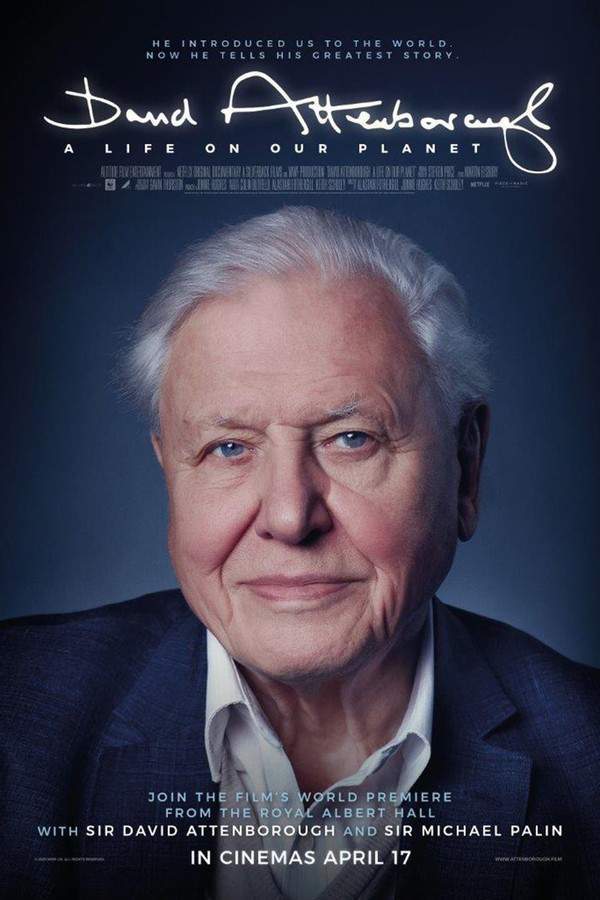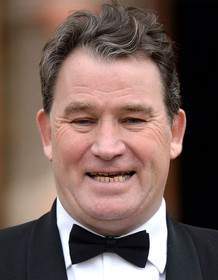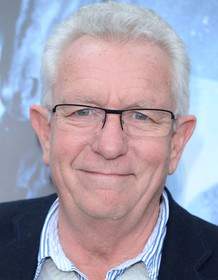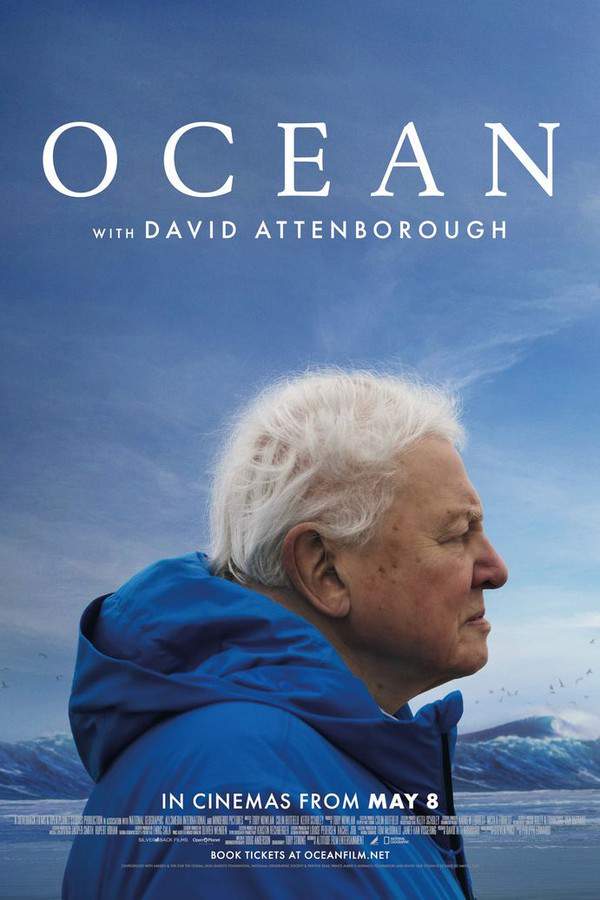David Attenborough: A Life on Our Planet 2020

Reflecting on a lifetime dedicated to exploring the natural world, renowned naturalist Sir David Attenborough delivers a powerful and personal account. He reveals how humanity’s progress has significantly impacted the Earth’s delicate ecosystems, posing a serious threat to the planet's future. Despite the concerning reality, Attenborough remains hopeful, advocating for immediate and decisive action to protect the wonders of nature and build a sustainable world for generations to come.
Does David Attenborough: A Life on Our Planet have end credit scenes?
No!
David Attenborough: A Life on Our Planet does not have end credit scenes. You can leave when the credits roll.
Meet the Full Cast and Actors of David Attenborough: A Life on Our Planet
Explore the complete cast of David Attenborough: A Life on Our Planet, including both lead and supporting actors. Learn who plays each character, discover their past roles and achievements, and find out what makes this ensemble cast stand out in the world of film and television.
External Links and Streaming Options
Discover where to watch David Attenborough: A Life on Our Planet online, including streaming platforms, rental options, and official sources. Compare reviews, ratings, and in-depth movie information across sites like IMDb, TMDb, Wikipedia or Rotten Tomatoes.
Ratings and Reviews for David Attenborough: A Life on Our Planet
See how David Attenborough: A Life on Our Planet is rated across major platforms like IMDb, Metacritic, and TMDb. Compare audience scores and critic reviews to understand where David Attenborough: A Life on Our Planet stands among top-rated movies in its genre.

The Movie Echo Score
David Attenborough: A Life on Our Planet offers a compelling fusion of personal testimony and urgent environmental advocacy. Reviews emphasize its impactful first-person narrative, emotional resonance drawn from Attenborough’s extensive career, and striking visual sequences. While a few note a tendency toward familiar documentary pacing and occasional didactic tone, the prevailing sentiment praises its persuasive call to action. Overall, the film leaves a lasting impression as both a poignant memoir and an urgent appeal for biodiversity preservation.
The Movie Echo Score Breakdown for David Attenborough: A Life on Our Planet

Art & Craft
In terms of art and craft, the documentary excels through its polished cinematography and cohesive editing. Critics highlight jaw-dropping landscape and wildlife photography, alongside seamless transitions between archival and contemporary footage. The production design and refined visual style elevate the presentation, creating a visually immersive experience. Ultimately, the film’s art direction reinforces its urgent environmental message.

Character & Emotion
When it comes to character and emotion, the film benefits from Attenborough’s authentic presence and measured narration. Viewers respond to his tone of humble authority and personal reflections drawn from decades of wildlife observation. The emotional resonance is deepened by moments of sorrow for lost species and sparks of hope for renewal. Overall, the human touch drives the documentary’s emotional core.

Story & Flow
In terms of story and flow, the narrative offers a clear progression from past discoveries to current ecological crises. The structure balances archival clips with modern footage, although some note that the first half can meander. Pacing is generally measured, providing adequate context for the overarching warning. In sum, the storyline effectively communicates urgency despite occasional lapses in momentum.

Sensory Experience
In terms of sensory experience, the documentary delivers an impactful audiovisual landscape. The score and soundtrack underscore moments of wonder and urgency without overpowering the narration. Sound design remains unobtrusive while highlighting key environmental scenes. Visually, the film leverages an understated color palette and crisp imagery to maintain cohesion. Overall, the sensory elements reinforce the film’s persuasive intent.

Rewatch Factor
When it comes to rewatch factor, the film’s compelling message and striking visuals encourage a second viewing for enthusiasts of nature documentaries. However, its didactic tone and familiar narrative framework may limit broader replay appeal. Audiences may return for specific segments featuring archival footage and key environmental milestones. In the end, the documentary offers moderate lasting appeal for viewers invested in ecological themes.

72
Metascore
9.1
User Score


96%
TOMATOMETER

96%
User Score

8.9 /10
IMDb Rating

84
%
User Score

4.2
From 87 fan ratings
Take the Ultimate David Attenborough: A Life on Our Planet Movie Quiz
Challenge your knowledge of David Attenborough: A Life on Our Planet with this fun and interactive movie quiz. Test yourself on key plot points, iconic characters, hidden details, and memorable moments to see how well you really know the film.
David Attenborough: A Life on Our Planet Quiz: Test your knowledge about the insights and themes presented by Sir David Attenborough in his impactful documentary.
What major historical event does the film highlight that significantly impacted biodiversity?
World War II
Chernobyl disaster
Berlin Wall
Apollo mission
Show hint
Awards & Nominations for David Attenborough: A Life on Our Planet
Discover all the awards and nominations received by David Attenborough: A Life on Our Planet, from Oscars to film festival honors. Learn how David Attenborough: A Life on Our Planet and its cast and crew have been recognized by critics and the industry alike.
74th British Academy Film Awards 2021

Full Plot Summary and Ending Explained for David Attenborough: A Life on Our Planet
Read the complete plot summary of David Attenborough: A Life on Our Planet, including all major events, twists, and the full ending explained in detail. Explore key characters, themes, hidden meanings, and everything you need to understand the story from beginning to end.
From the once bustling city of Pripyat, now a desolate landscape after the catastrophic Chernobyl disaster in April 1986, David Attenborough reflects on his remarkable life journey. With a rich tapestry of archival footage showcasing his illustrious career and a diverse array of ecosystems, he poignantly narrates pivotal experiences while highlighting the intricate balance of wildlife and biodiversity on our planet. Attenborough emphasizes the critical interdependence between plants and animals, and warns that human actions are threatening this equilibrium. He asserts that if the natural world diminishes, humanity’s own survival is at stake.
In 1937, the world population stood at 2.3 billion, with 280 parts per million of carbon dioxide in the atmosphere and 66% of wilderness remaining. Fondly recalling his childhood fascination with fossils, he explains that Earth’s history is characterized by gradual changes punctuated by mass extinction events, with five significant ones recorded over the planet’s four billion-year timeline. The last such event led to the demise of the dinosaurs and approximately 75% of all species. Life, however, gradually recovered.
Throughout the Holocene epoch, which has lasted for over 10,000 years, the average temperature has remained stable within a one-degree range. This stability can be attributed to forests and phytoplankton acting as carbon sinks, while animals play essential roles in enriching soils across plains. The equatorial jungles serve as energy reservoirs, contributing moisture and oxygen vital for life. In contrast, polar ice caps reflect sunlight, helping to keep the Earth cool. This harmonious cycle has historically enabled reliable seasonal patterns, with monsoons nurturing the land and allowing human society to flourish through agriculture.
By 1954, the global population had increased to 2.7 billion, with rising carbon levels at 310 ppm and 64% of wilderness remaining. Attenborough’s documentary career took off in the 1950s at the BBC, where he traveled to places like the African Serengeti, home to vast herds of native animals that require expansive territories to sustain their grazing habits. The disruption of these grasslands threatens the integrity of the entire ecosystem.
In 1968, the Apollo mission offered a stunning perspective of Earth as a solitary and vulnerable sphere that requires protection. Progressing to 1978, the world faced a population of 4.3 billion, with carbon levels rising to 335 ppm and wilderness reduced to 55%. Over the years, Attenborough noted marked declines in wildlife, whether searching for fish or orangutans in Borneo. The declining numbers resulted in stark revelations; only 300 gorillas were spotted in the remote jungles of Central Africa, and the once thriving whale populations fell victim to human hunting. Once seen as a sport, killing whales transformed into a global outcry against the practice.
As human populations surged unchecked, without natural predators and with diseases managed, food production blossomed. However, this boon came at a steep cost; entire habitats were erased. Borneo’s rainforests, once thriving, are now half destroyed, converted to oil palm monocultures, extinguishing the region’s vital biodiversity. Attenborough starkly reveals that three trillion trees have been felled globally, with half of the world’s rainforests already lost, resulting in a dramatic two-thirds reduction in orangutan populations in Borneo.
Fast-forward to 1997, and the world population grew to 5.9 billion, with carbon levels at 360 ppm and only 46% of wilderness left. Oceans, which once seemed untouchable, have now been ravaged as fishing fleets target nutrient hot spots, decimating 90% of large fish populations since the 1950s. The removal of these fish has disrupted nutrient circulation, leading to the slow death of the oceans and the bleaching of coral reefs. As the Earth warms due to rising atmospheric carbon, the balance of life within marine ecosystems is irrevocably altered.
As the 90s progressed, the planet’s average temperature increased by one degree since the 1930s. Areas like the Arctic and Antarctic showed unprecedented changes, with summer sea ice in the Arctic reducing by 40% over 40 years. Attenborough identifies anthropogenic climate change and biodiversity loss as primary forces pushing Earth toward a sixth mass extinction, a far quicker process than the extensive timespans of previous events.
By 2020, the global population reached 7.8 billion, with atmospheric carbon at 415 ppm and only 35% of wilderness remaining. Attenborough poignantly describes his film as a “witness statement,” illustrating the consequences of current trajectories on our planet through the lens of his own lifetime. He warns that the Amazon rainforest could morph into savanna, losing moisture production and altering the global water cycle; summer ice in the Arctic may vanish, accelerating climate change; coral reefs could perish while soil depletion leads to food scarcity. These irreversible changes would catalyze mass extinctions as Earth warms by four degrees by the century’s end.
Yet, Attenborough remains hopeful, outlining potential remedies to avert these dire outcomes. He insists the solution is “staring us in the face all along.” To reestablish harmony on our planet, we need to rejuvenate its biodiversity—what has been systematically erased. He advocates for rewilding and suggests that alleviating poverty, ensuring universal healthcare, and enhancing girls’ education could stabilize the burgeoning human population. Furthermore, he promotes renewable energy sources—solar, wind, water, and geothermal—capable of sustainably meeting human energy demands. Protecting a third of coastal regions from fishing could allow fish stocks to replenish, ensuring adequate supplies for human consumption. Lastly, Attenborough encourages dietary shifts toward plant-based foods to optimize land use. He cites successful government initiatives, like those in Costa Rica reversing deforestation, fishing regulations in Palau, and land management improvements in the Netherlands as exemplary case studies for restoration efforts.
Uncover the Details: Timeline, Characters, Themes, and Beyond!

Coming soon on iOS and Android
The Plot Explained Mobile App
From blockbusters to hidden gems — dive into movie stories anytime, anywhere. Save your favorites, discover plots faster, and never miss a twist again.
Sign up to be the first to know when we launch. Your email stays private — always.
Watch Trailers, Clips & Behind-the-Scenes for David Attenborough: A Life on Our Planet
Watch official trailers, exclusive clips, cast interviews, and behind-the-scenes footage from David Attenborough: A Life on Our Planet. Dive deeper into the making of the film, its standout moments, and key production insights.
David Attenborough: A Life on Our Planet Themes and Keywords
Discover the central themes, ideas, and keywords that define the movie’s story, tone, and message. Analyze the film’s deeper meanings, genre influences, and recurring concepts.

Unlock the World of Movies with Our Comprehensive Wiki
Dive into our Movie Wiki for in-depth film encyclopedia entries, including cast biographies, production trivia, plot synopses, behind-the-scenes facts, and thematic analyses. Whether you’re researching iconic directors, exploring genre histories, or discovering hidden easter eggs, our expertly curated movie database has everything you need to fuel your cinematic passion.

Articles, Reviews & Explainers About David Attenborough: A Life on Our Planet
Stay updated on David Attenborough: A Life on Our Planet with in-depth articles, critical reviews, and ending explainers. Explore hidden meanings, major themes, and expert insights into the film’s story and impact.
Similar Movies To David Attenborough: A Life on Our Planet You Should Know About
Browse a curated list of movies similar in genre, tone, characters, or story structure. Discover new titles like the one you're watching, perfect for fans of related plots, vibes, or cinematic styles.
Quick Links: Summary, Cast, Ratings, More

What's After the Movie?
Not sure whether to stay after the credits? Find out!
Explore Our Movie Platform
New Movie Releases (2026)
Famous Movie Actors
Top Film Production Studios
Movie Plot Summaries & Endings
Major Movie Awards & Winners
Best Concert Films & Music Documentaries
Movie Collections and Curated Lists
© 2026 What's After the Movie. All rights reserved.


































